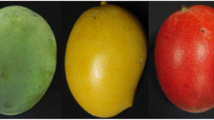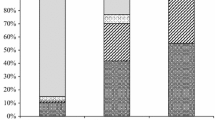Abstract
Phytonutrient metabolism in sour cherries takes place during fruit ripening. This study demonstrated that total phenolic–flavonoid contents decline during ripening while total anthocyanin content significantly increases at the same period. There were no detectable anthocyanins in green cherry fruits. Anthocyanin biosynthesis started concurrently with color formation. Cyanidin-3-glucosylrutinoside and cyanidin-3-rutinoside were the early anthocyanins accumulated in fruits and were accompanied with cyanidin-3-sophoroside and cyanidin-3-glucoside in fully ripe fruits. Phenylpropanoid pathway involves anthocyanin biosynthesis, and chalcone synthase (CHS) is one of the key enzymes regulating the pathway. Three CHS genes (PcChs1, PcChs2, PcChs3) were isolated from sour cherry genome, and their transcription profiles were determined using the RT-PCR approach. There was no CHS gene expression before breaker stage, and PcChs1, PcChs2, PcChs3 transcription were upregulated in parallel with pigmentation in sour cherry cells and PcChs1 had the highest transcripts in fully ripe fruits.


Similar content being viewed by others
References
Kang SY, Seeram NP, Nair MG, Bourquin LD (2003) Tart cherry anthocyanins inhibit tumor development in ApcMin mice and reduce proliferation of human colon cancer cells. Cancer Lett 194:13–19
Wang H, Nair MG, Strasburg GM, Chang YC, Booren AM, Gray JI, Dewitt DL (1999) Antioxidant and antiinflammatory activities of anthocyanins and their aglycon, cyanidin, from tart cherries. J Nat Prod 62:294–296
Connolly DAJ, McHugh MP, Padilla-Zakour OL (2006) Efficacy of a tart cherry juice blend in preventing the symptoms of muscle damage. Br J Sports Med 40:679–683
Kuehl KS, Perrier ET, Elliot DL, Chesnutt JC (2010) Efficacy of tart cherry juice in reducing muscle pain during running: a randomized controlled trial. J Int Soc Sports Nutr 7:7–17
Kelley DS, Rasooly R, Jacob RA, Kader AA, Mackey BE (2006) Consumption of bing sweet cherries lowers circulating concentrations of inflammation markers in healthy men and women. J Nutr 136:981–986
Howatson G, Bell PG, Tallent J, Middleton B, McHugh MP, Ellis J (2012) Effect of tart cherry juice (Prunus cerasus) on melatonin levels and enhanced sleep quality. Eur J Nutr 51:909–916
Heller W, Hahlbrock K (1980) Highly purified flavanone synthase from parsley catalyzes the formation of naringenin chalcone. Arch Biochem Biophys 200:617–619
Jiang C, Kim SY, Suh D-Y (2008) Divergent evolution of the thiolase superfamily and chalcone synthase family. Mol Phylogenet Evol 49:691–701
Poll L, Petersen M, Nielsen GS (2003) Influence of harvest year and harvest time on soluble solids, titrateable acid, anthocyanin content and aroma components in sour cherry (Prunus cerasus L. cv. “Stevnsbær”). Eur Food Res Technol 216(3):212–216
Lodhi MA, Guang-Ning Y, Weeden NF, Reisch BI (1994) A simple and efficient method for DNA extraction from grapevine cultivars, vitis species and ampelopsis. Plant Mol Biol 12:6–13
Lopez-Gomez R, Gomez-Lim MA (1992) A method for extracting intact RNA from fruits rich in polysaccharides using ripe mango mesocarp. HortScience 27:440–442
Liu M, Li XQ, Weber C, Lee CY, Brown J, Liu RH (2002) Antioxidant and antiproliferative activities of raspberries. J Agric Food Chem 50:2926–2930
Lee J, Durst RW, Wrolstad RE (2005) Determination of total monomeric anthocyanin pigment content of fruit juices, beverages, natural colorants, and wines by the pH differential method: collaborative study. J AOAC Int 88:1269–1278
Karaaslan M, Yilmaz FM, Cesur Ö, Vardin H, Ikinci A, Dalgiç AC (2014) Drying kinetics and thermal degradation of phenolic compounds and anthocyanins in pomegranate arils dried under vacuum conditions. Int J Food Sci Technol 49(2):595–605
Re R, Pellegrini N, Proteggente A, Pannala AS, Yang M, Rice-Evans CA (1999) Antioxidant activity applying an improved ABTS radical cation decolorization assay. Free Radic Biol Med 26:1231–1237
Blando F, Gerardi C, Nicoletti I (2004) Sour cherry anthocyanins as ingredients for functional foods. J Biomed Biotechnol 5:253–258
Benzie IF, Strain J (1996) The ferric reducing ability of plasma (FRAP) as a measure of “Antioxidant Power”: the FRAP assay. Anal Biochem 239:70–76
Garofulić IE, Dragović-Uzelac V, Jambrak AR, Jukić M (2013) The effect of microwave assisted extraction on the isolation of anthocyanins and phenolic acids from sour cherry Marasca (Prunus cerasus var. Marasca). J Food Eng 117:437–442
Kirakosyan A, Seymour EM, Urcuyo Llanes DE, Kaufman PB, Bolling SF (2009) Chemical profile and antioxidant capacities of tart cherry products. Food Chem 115:20–25
Simunic V, Kovac S, Gaso-Sokac D, Pffannhauser W, Murkovic M (2005) Determination of anthocyanins in four Croatian cultivars of sour cherries. Eur Food Res Technol 220:575–578
Tomàs-Barberàn FA, Gil MI, Cremin P, Waterhouse AL, Hess-Pierce B, Kader AA (2001) HPLC–DAD–ESIMS analysis of phenolic compounds in nectarines, peaches, and plums. J Agric Food Chem 49:4748–4760
el Amira A, Behija SE, Beligh M, Lamia L, Manel I, Mohamed H, Lotfi A (2012) Effects of ripening stage on phenolic profile, phytochemical composition and antioxidant activity at date palm fruit. J Agric Food Chem 60:10896–10902
Myhara RM, Karkalas J, Taylor MS (1999) The composition of maturing Omani dates. J Sci Food Agric 79:1345–1350
Amiot JM, Tacchini M, Aubert SY, Oleszek W (1995) Influence of cultivar, maturity stage and storage conditions on phenolic composition and enzymatic browning of pear fruit. J Agric Food Chem 43:1132–1137
Allaith AAA (2008) Antioxidant activity of Bahraini date palm (Phoenix dactylifera L.) fruit of various cultivars. Int J Food Sci Technol 43:1033–1040
Awad MA, Al-Qurashia AD, Mohamed SA (2011) Antioxidant capacity, antioxidant compounds and antioxidant enzyme activities in five date cultivars during development and ripening. Sci Hort 129:688–693
Prior RL, Wu X, Schaich K (2005) Standardized methods for the determination of antioxidant capacity and phenolics in foods, and dietary supplements. J Agric Food Chem 53:4290–4302
Wiczkowski W, Szawara-Nowak D, Topolska J (2015) Changes in the content and composition of anthocyanins in red cabbage and its antioxidant capacity during fermentation, storage and stewing. Food Chem 167:115–123
Huang D, Ou B, Hampsch-Woodill M, Flanagan JA, Prior RL (2002) High-throughput assay of oxygen radical absorbance capacity (ORAC) using a multichannel liquid handling system coupled with a microplate fluorescence reader in 96-well format. J Agric Food Chem 50:4437–4444
Ou B, Hampsch-Woodill M, Prior RL (2001) Development and validation of an improved oxygen radical absorbance capacity assay using fluorescein as the fluorescent probe. J Agric Food Chem 49:4619–4626
Thaipong K, Boonprakob U, Crosby K, Cisneros-Zevallos L, Byrne DH (2006) Comparison of ABTS, DPPH, FRAP, and ORAC assays for estimating antioxidant activity from guava fruit extracts. J Food Compos Anal 19:669–675
Proteggente AR, Pannala AS, Paganga G, Van Buren L, Wagner E, Wiseman S, Van De Put F, Dacombe C, Rice-Evans CA (2002) The antioxidant activity of regularly consumed fruit and vegetables reflects their phenolic and vitamin C composition. Free Radic Res 36:217–233
Lister CE, Wilson PE, Sutton KH, Morrison SC (2002) Understanding the health benefits of blackcurrants. Acta Hort 585:443–449
Schlesier K, Harwat M, Böhm V, Bitsch R (2002) Assessment of antioxidant activity by using different in vitro methods. Free Radic Res 36:177–187
Chaovanalikit A, Wrolstad RE (2004) Anthocyanin and polyphenolic composition of fresh and processed cherries. J Food Sci 69:73–83
Eid NM, Al-Awadi B, Vauzour D, Oruna-Concha MJ, Spencer JP (2013) Effect of cultivar type and ripening on the polyphenol content of date palm fruit. J Agric Food Chem 61:2453–2460
Delgado R, Martín P, del Álamo M, González M-R (2004) Changes in the phenolic composition of grape berries during ripening in relation to vineyard nitrogen and potassium fertilisation rates. J Sci Food Agric 84:623–630
Liang Z, Sang M, Fan P, Wu B, Wang L, Duan W, Li S (2011) Changes of polyphenols, sugars, and organic acid in 5 Vitis genotypes during berry ripening. J Food Sci 76:1231–1238
Holoton TA, Cornish EC (1995) Genetics and biochemistry of anthocyanin biosynthesis. Plant Cell 7:1071–1083
Tsuda T, Yamaguchi M, Honda C, Moriguchi T (2004) Expression of anthocyanin biosynthesis genes in the skin of peach and nectarine fruit. J Am Soc Hortic Sci 129:857–862
Boss PK, Davies C, Robinson SP (1996) Analysis of the expression of anthocyanin pathway genes in developing Vitis vinifera L. cv Shiraz grape berries and the implications for pathway regulation. Plant Physiol 111:1059–1066
Boss PK, Davies C, Robinson SP (1996) Expression of anthocyanin biosynthesis pathway genes in red and white grapes. Plant Mol Biol 32:565–569
Honda CN, Kotoda M, Wada S, Kondo S, Kobayashi J, Soejima Z, Zhang T, Tsuda T, Moriguchi T (2002) Anthocyanin biosynthetic genes are coordinately expressed during red coloration in apple skin. Plant Physiol Biochem 40:955–962
Kobayashi S, Ishimaru M, Ding CK, Yakushiji H, Goto N (2001) Comparison of UDP-glucose: flavonoid 3-O-glucosyltransferase (UFGT) gene sequences between white grapes (Vitis vinifera) and their sports with red skin. Plant Sci 160:543–550
Kondo S, Hiraoka K, Kobayashi S, Honda C, Terahara N (2002) Changes in the expression of anthocyanin biosynthetic genes during apple development. J Am Soc Hortic Sci 127:971–976
Li Y, Sakiyama R, Maruyama H, Kawabata S (2001) Regulation of anthocyanin biosynthesis during fruit development in ‘Nyoho’ strawberry. J Jpn Soc Hortic Sci 70:28–32
Moyano E, Portero-Robles I, Medina-Escobar N, Valpuesta V, Munoz-Blanco J, Caballero JL (1998) A fruit-specific putative dihydroflavonol 4-reductase gene is differentially expressed in strawberry during the ripening process. Plant Physiol 117:711–716
Parker JL (2010) What makes a cherry red: an investigation into flavonoid pathway regulation in sweet cherry (Prunus avium L.) fruit. Ph.D. Thesis, The University of Adelaide
Mori T, Sakurai M, Sakuta M (2001) Effects of conditioned medium on activities of PAL, CHS, DAHP synthase (DS-Co and DS-Mn) and anthocyanin production in suspension cultures of Fragaria ananassa. Plant Sci 160:355–360
Davis G, Ananga A, Krastanova S, Sutton S, Ochieng JW, Leong S, Tsolova V (2012) Elevated gene expression in chalcone synthase enzyme suggests an increased production of flavonoids in skin and synchronized red cell cultures of North American native grape berries. DNA Cell Biol 31:939–945
Acknowledgments
The research support from TÜBİTAK (Project# 112O001) is gratefully acknowledged by the authors.
Author information
Authors and Affiliations
Corresponding author
Ethics declarations
Conflict of interest
The authors declare that they have no conflict of interest.
Compliance with Ethics Requirements
This article does not contain any studies with human or animal subjects.
Rights and permissions
About this article
Cite this article
Karaaslan, M., Yılmaz, F.M., Karaaslan, A. et al. Synthesis and accumulation of anthocyanins in sour cherries during ripening in accordance with antioxidant capacity development and chalcone synthase expression. Eur Food Res Technol 242, 189–198 (2016). https://doi.org/10.1007/s00217-015-2530-y
Received:
Revised:
Accepted:
Published:
Issue Date:
DOI: https://doi.org/10.1007/s00217-015-2530-y




